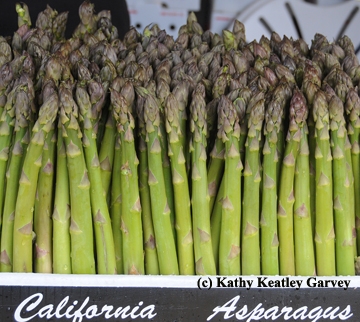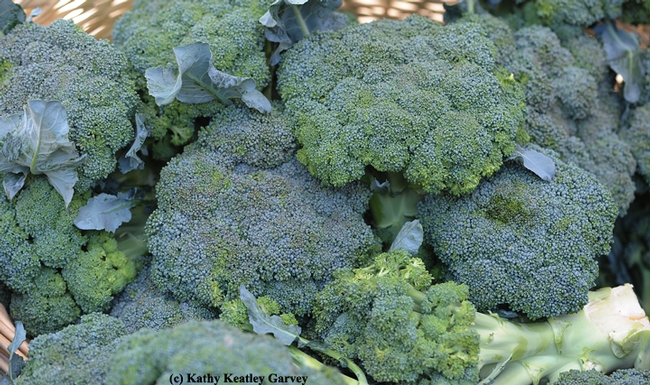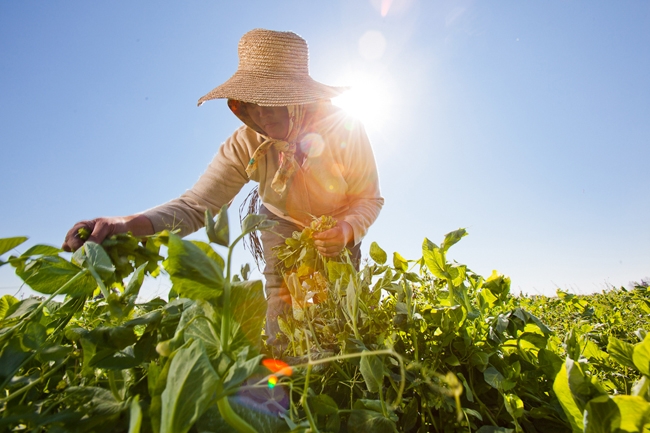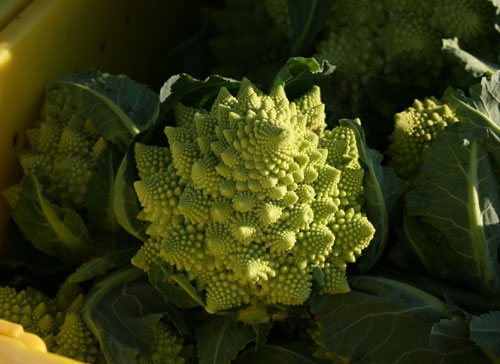Posts Tagged: Broccoli
The joy of eating green: Ten things you should know about saving money and eating healthier

You're famished. The potato chips look good. The glazed doughnuts look even better. And that chocolate candy bar? To die for.
Bring ‘em on!
No, wait a minute. Let's get real, let's get green and let's get healthy. And let's save some money.
Nutritionist Amy Block Joy, Cooperative Extension specialist emeritus, teaches a University of California, Davis, freshman class on “Eating Green” and we asked her for the 10 best ways to save money and eat healthier.
Joy, who holds a doctorate in nutritional sciences from UC Berkeley, specializes in nutrition and health disparities of diverse populations and nutritional ecology, as well as workplace ethics.
Her advice needs to be posted on every refrigerator in the country. (Along with that shopping list!)
- Shop with a list: Using a list will keep you focused on meal planning and reduce the temptation to buy unneeded items.
- Don't shop when you're hungry: Temptation is high when you're hungry. Eat first and you'll be less inclined to spend extra dollars on those food items placed near the check-out stand that are high in calories and fat and low in nutrition. That would be snacks! Try shopping after a meal and you will find yourself less tempted by those chocolate-covered pretzels!
- Read the nutrition facts label: When shopping for the healthiest foods, you should read the nutrition fact labels to check out fat, calories, fiber, carbohydrates and sodium. Aim for low-fat, high-fiber foods that have essential vitamins and minerals. For example, if you want the best source of fiber - buy fresh oranges and eat them raw rather than selecting orange juice. However, if you want juice, be sure that you are getting real juice. And, some juices are now fortified with calcium - a big plus for increasing your calcium intake if you are not drinking milk.
 Please don't pass by the peas. (Photo by Kathy Keatley Garvey)
Please don't pass by the peas. (Photo by Kathy Keatley Garvey) - Read the ingredient lists: The ingredient list will provide important clues on products that you'll want to include in your diet. One of them is to look for whole grains. The information on the product may make you think the product is "natural" but what does that really mean? Not much because the phrase you want to look for is the "USDA organic" label. With so many choices of breads these days, you'll want to find ones that have whole grains and fiber. Find the information by reading the label (compare fiber amounts) and ingredients (look for "whole" grains).
- Compare prices: Supermarkets provide price-comparison information located by their products. You can compare the "unit" costs so that you'll be able to determine the lowest cost of the product. Two words of caution: products "on sale" may not be the best bargains.
 Asparagus is part of going green. There's also a white variety now. (Photo by Kathy Keatley Garvey)
Asparagus is part of going green. There's also a white variety now. (Photo by Kathy Keatley Garvey) - Shop the perimeter of the store: Marketing experts have placed the healthiest foods at the farthest corners of the store so that the shopper has to stroll through the other items before finding fruits and vegetables, protein sources (poultry, meats), dairy products and cereal products.
- Think protein: Buy meat and poultry on sale and use these foods to make stews, soups and chili. This way you can stretch these more expensive food sources. Beans are a great source of protein and are low fat and high in fiber.
- Plan meals ahead: The best way to save money is to plan your meals in advance. Buying unprocessed foods will improve your health and also save money. It costs to add preservatives, food additives and packaging of products that you, the consumer, are paying for. It's much cheaper to buy rice in bulk rather than already prepared rice products. Brown rice contains more fiber than white rice.
- Cook! Your grandmother was right. Food prepared from scratch will taste better, be healthier and save money. Research has shown that cooking not only saves money but improves nutrition.
- Enjoy! Food is meant to be a pleasant happy experience. Don't forget to enjoy it!
So, the next time you're racing out the door on your way to the supermarket, be sure to eat first so you're not tempted by foods that you know aren't good for you.
And that shopping list? You can also key that in on your cell phone so neither the list, nor your phone, will get left behind.
Meanwhile, we all ought to follow Amy Block Joy's great advice on saving money, eating green, and being healthier.
As I wrote on one of my college essays, "We have a choice in the matter and it matters that we have a choice."

The produce aisle is a good place to "go green and eat healthier." (Photo by Kathy Keatley Garvey)

Grocery stores usually place fruits and vegetables around the perimeter. (Photo by Kathy Keatley Garvey)

Broccoli--a food everyone should love. (Photo by Kathy Keatley Garvey)
Cultivating California

In the late 1800s, University of California researchers discovered how to remove salts from the soils of the Central Valley, turning it into one of the most productive agricultural regions.
UC researchers continue to play a key role in agriculture today, keeping California the nation’s leading agricultural state, from dairies in Tulare to nut farms in Newberry Springs.
A new brochure highlights the breadth of UC Agriculture and Natural Resources’ impact. UC guidelines have helped farmers boost broccoli production. UC scientists have developed sweet-tasting citrus and strawberries to meet consumer demands. UC certifies more than 95 percent of wine grapevines grown in the state, providing a reliable supply of high-quality vines for California’s multibillion-dollar wine industry. Whether it’s managing invasive pests, promoting nutrition or sustaining small farmers, ANR serves California’s communities with a focus on advising, educating and searching for solutions.
For more information, read the Cultivating California brochure.

uc anr minibrochure cover s2
Survey identifies 19 produce candidates for a farm-to-WIC program
A new federal voucher that gives low-income women access to a range of fruits and vegetables could provide unique new marketing opportunities for California growers.
In 2009, the federal Special Supplemental Nutrition Program for Women, Infants and Children (WIC) began distributing monthly cash vouchers to low-income women with children to buy fruits and vegetables. The program reaches almost half of the infants and one-quarter of children under 5 years old in the United States.
A team of UC Cooperative Extension (UCCE) researchers and nutrition advisors has been exploring the possibility of developing a farm-to-WIC program that would link these low-income consumers with local growers. The purpose of such a program would be to increase the consumption of a wide variety of fresh produce, with a focus on locally grown produce when available.
UCCE conducted a survey of produce preferences and buying habits among WIC participants in Tulare, Alameda and Riverside counties in 2010. The full study is published in the January-March 2012 issue of California Agriculture journal.
Based on the results, the UCCE team developed a list of 19 produce items to promote in a possible new farm-to-WIC program. They are:
|
|
|
Although mustard greens and collards were not popular across all sites, the advisors gauged a potential market in Alameda County, so these were retained. Based on write-in responses, oranges were also added.
In California, which has the nation's largest WIC program, 82 local agencies serve about 1.43 million participants at 623 local centers, and WIC participants can redeem their monthly vouchers at 4,000 grocery stores statewide. About 40 percent shop at WIC-only stores, which stock and sell only WIC-authorized foods.
Stocking produce is relatively new to WIC-only stores; before rollout of new WIC food packages in October 2009, these stores were only required to stock limited amounts of fresh carrots. In the survey, most WIC participants (58 percent to 72.3 percent) responded that their preferred stores offered many choices, but fewer participants (18.5 percent to 41 percent) rated the produce quality as “excellent.” Key factors determining purchase decisions were produce quality and freshness, and nutrient value (vitamins and minerals). Cost was relatively less important, possibly because WIC participants procure the produce with the vouchers.
The list has served as a starting point for discussions with growers and WIC vendors.
“The survey showed that WIC participants were interested in purchasing fresh produce with better quality and more variety,” wrote lead author Lucia L. Kaiser, Cooperative Extension specialist in the UC Davis Department of Nutrition, and co-authors, in California Agriculture. “Some WIC participants that we surveyed said they avoided shopping at WIC-only stores in part because these interests were not met.”

A dish made with nopales (cactus pads).
Cruciferous vegetables help fight cancer
The role fresh vegetables play in maintaining good health is no secret. But, according to a University of California scientist, eating from a particular group of vegetables can help protect the body from lethal illnesses like cancer.
These extraordinary vegetables are in the cruciferous family - including broccoli, kale, cauliflower and Brussels sprouts.
UC Berkeley toxicology professor Len Bjeldanes says cruciferous vegetables are good sources of the natural chemical compound diindolilmentano, or DIM. DIM suppressed harmful cells in studies with rats and Bjeldanes believes it can have the same effect in combating cancer in humans.
"We were really surprised to see that we've got about an 80 percent reduction in the amount of virus that could proliferate in those animals when we gave them the combination with DIM," said Bjeldanes, who is conducting the experiments with colleague Gary Firestone, a molecular biologist. "This is really a very strong indication that this is helping the body deal with these immune insults, like in this case a virus."
Bjeldanes said prostate cancer is sensitive to androgen, a male hormone.
“This makes our finding that cruciferous plants contain an anti-androgen important,” he said. "DIM is the first example of a naturally occurring anti-androgen from plants that we know of. So this is quite remarkable."
DIM may also play a role in suppressing breast cancer.
"We had been studying for some time the effects of the vegetables on mammary and breast cancer and there's a fair amount of information that says indeed, they are in fact protective of mammary and breast cancer," he said.
The scientists will next determine whether protective effects of DIM found in experiments with rats will manifest themselves in human studies.
Bejeldanes cautions that eating cruciferous vegetables is not a miracle cure for cancer. But he encourages people to include vegetables rich in DIM in their diets. The vegetables will give a boost to the body’s immune system, enabling it to defend against all manner of illnesses.
"These are chemicals that are important in activating the immune response and help the body fight the bad guys, like bacteria or viruses,” he said.
To get the most immune-boosting compounds from broccoli and other cruciferous vegetables, nutrition experts suggest eating them raw, in salads, or lightly steamed. Boiling the vegetables destroys more than half the nutrients.
(Original article by Alberto Hauffen. Adapted to English by Jeannette Warnert.)

Romanesco cauliflower is one of the more unusual cruciferous vegetables.
Love those greens
Remember when George Herbert Walker Bush, the 41st president of the United States, declared he didn’t like broccoli and declined to eat it?
“I do not like broccoli,” said Bush, who served as President from 1989 to 1993. “And I haven’t liked it since I was a little kid and my mother made me eat it. And I'm President of the United States and I'm not going to eat any more broccoli.”
Well, all the broccoli-haters out there need to come up with some different anti-broccoli strategies.
Mom was right all along. Broccoli, Brussels sprouts and other cruciferous vegetables in the Brassica family (such as kale, cabbage and collard greens) are good for you.
Especially broccoli and Brussels sprouts, which have anticancer effects and other health benefits, researchers say.
Researchers at the Ohio State University Comprehensive Cancer Center-Arthur G. James Cancer Hospital and Richard J. Solove Research Institute have discovered that a substance in broccoli and Brussels sprouts can block the proliferation of cancer cells.
The substance is indole-3-carbinol (I3C).
In research published June 29 in the journal Cancer Prevention Research, the scientists said they discovered a connection between I3C and a molecule called Cdc25A, essential for cell division and proliferation. The research showed that I3C "causes the destruction of that molecule and thereby blocks the growth of breast cancer cells."
Cdc25A, they said, occurs at abnormally high levels in cancers of the breast, prostate, liver, esophagus, endometrium and colon, and in non-Hodgkin lymphoma, and in other diseases such as Alzheimer’s.
“I3C can have striking effects on cancer cells,” said study leader Xianghong Zou, assistant professor of pathology at The Ohio State University Medical Center. A better understanding of this mechanism, he said, "may lead to the use of this dietary supplement as an effective and safe strategy for treating a variety of cancers and other human diseases associated with the overexpression of Cdc25A." (See online news story.)
Grocery stores and farmers' markets need to stock more broccoli and Brussels sprouts this week.
So, how do you prepare these greens? Here are the traditional ways, ala the Betty Crocker cookbook:
Broccoli: For a pound and a half: Remove large leaves and ends of tough stalks. If thick, gash stem several times. Boil 10 to 15 minutes. Serve buttered, with salt and pepper. Vary with oregano and lemon juice, Hollandaise sauce, or grated cheese.
Brussel Sprouts: For a pound and a half: Remove discolored leaves and stem ends. Leave whole. Boil 8 to10 minutes. Serve buttered, with salt and pepper. Vary with garlic salt, basil, dill, caraway, savory or cumin.
The cookbook, Country Cooking…California Style, published by the California Farm Bureau Women, includes several recipes for broccoli and one for Brussels sprouts. After all, California grows more of these two vegetables than any other state in the country.
Here are two Country Cooking recipes:
Walnut Broccoli
3 heads broccoli, chopped
1/2 cup butter
4 tablespoons flour
1-1/2 teaspoons powdered chicken stock base
2 cups milk
2/3 cup water
6 tablespoons butter
2/3 package seasoned stuffing
2/3 cup walnuts, chopped
Heat oven to 350 degrees. Cook broccoli just under tender. Drain and put in flat 2-quart casserole. Melt 1/2 cup butter, blend in flour and cook gently over low heat. Add chicken stock base. Gradually add milk, cooking until smooth and thick; pour over broccoli. Heat water and 6 tablespoons butter until melted. Pour over stuffing mix and toss; add nuts. Top broccoli with stuffing. Bake 30 minutes at 350 degrees. The amount of water used with stuffing mix may have to be adjusted to make a moist combination. Serves 12.
Coastal Brussels Sprouts Piquant
3 cups Brussels sprouts
1/3 cup mayonnaise
1/4 cup water
2 teaspoons horseradish
2 tablespoons grated onion
1/2 cup bread crumbs
Preheat over to 375 degrees. Cook sprouts in rapidly boiling water until barely tender. Drain and transfer to shallow casserole. Combine mayonnaise, water, horseradish and onion. Pour over sprouts. Top with bread crumbs. Bake 20 minutes. Serves four.

Broccoli and Brussels sprouts

